Featured Articles
- 01 GPT vs MBR: Which Is Better
- 02 Set Up the Boot Mode in MBR for BIOS, Legacy or UEFI
- 03 Convert MBR to GPT Without Data Loss (Windows 11 Available)
- 04 Running [Bootrec /fixboot] Returned Error 'Access is denied'
- 05 How to Install Windows 11 on MBR?
- 06 Fix 'Windows Cannot Be Installed to This Disk MBR'
- 07 Fix MBR2GPT Conversion Failed
- 08 How to Rebuild MBR
- 09 FREE MBR Repair Tool
In setting up a computer, configuring the correct boot mode for your OS drive is essential.
While installing Windows, if you receive the error message: "Windows cannot be installed to the disk. The selected disk is not of the GPT partition style", it means your PC is booted in UEFI mode, but your hard drive is not configured for UEFI mode.
Here is the right way to get rid of this problem:
In this article, you'll learn:
- #1. Confirm If Computer Is Shipped with BIOS or UEFI Firmware
- #2. Check If Windows Supports MBR or GPT
- #3. Set Up Right Boot Mode in MBR for BIOS - Legacy or UEFI
Let's get started here.
#1. Confirm If Computer Is Shipped with BIOS or UEFI Firmware
To configure the right boot mode for your operating system, it's important you first learn the two boot modes in Windows - BIOS (Legacy) and UEFI. So what is UEFI, and what are the differences between UEFI and BIOS?
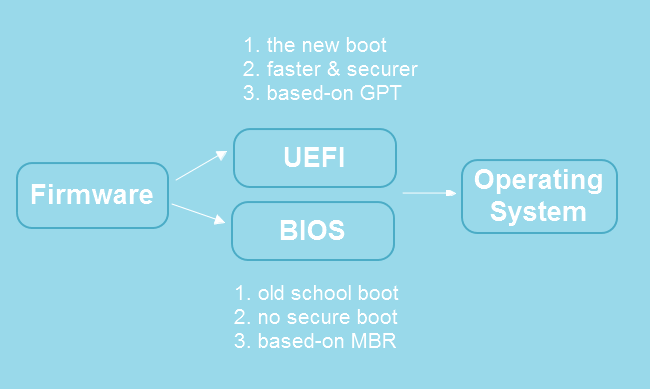
To get started, let's first learn the difference between BIOS and UEFI first:
| Comparison | BIOS | UEFI |
|---|---|---|
| Definition | BIOS, short for Basic Input-Output system, is low-level software that is responsible for waking up your computers' hardware components, ensuring they're functioning properly, and running the bootloader to boot Windows and other operating systems you have installed. | UEFI is also low-level software that is responsible for booting your PC and the OS. UEFI is a more modern solution that supports larger hard drives, faster boot times, more security features, and convenient graphics and mouse cursors. |
| Differences |
|
|
Intel has announced plans to completely replace BIOS with EUFI on all their chipsets by 2020.
If your Windows computers are shipped with Intel chips after 2020, all of them will require UEFI boot mode.
But, if your computer is older than this and was shipped before 2020, how can you tell if your computer is BIOS or UEFI? Here are the steps that you can follow to figure out the boot mode in your computer firmware:
Option 1: Use System Information to Check If Your PC Used BIOS or UEFI
Step 1. Open Start, type system information in the search box, and click to open it.
Step 2. Find the BIOS Mode under System Summary.
- If it says Legacy, your device is using BIOS.
- If it says UEFI, your PC is running with UEFI.
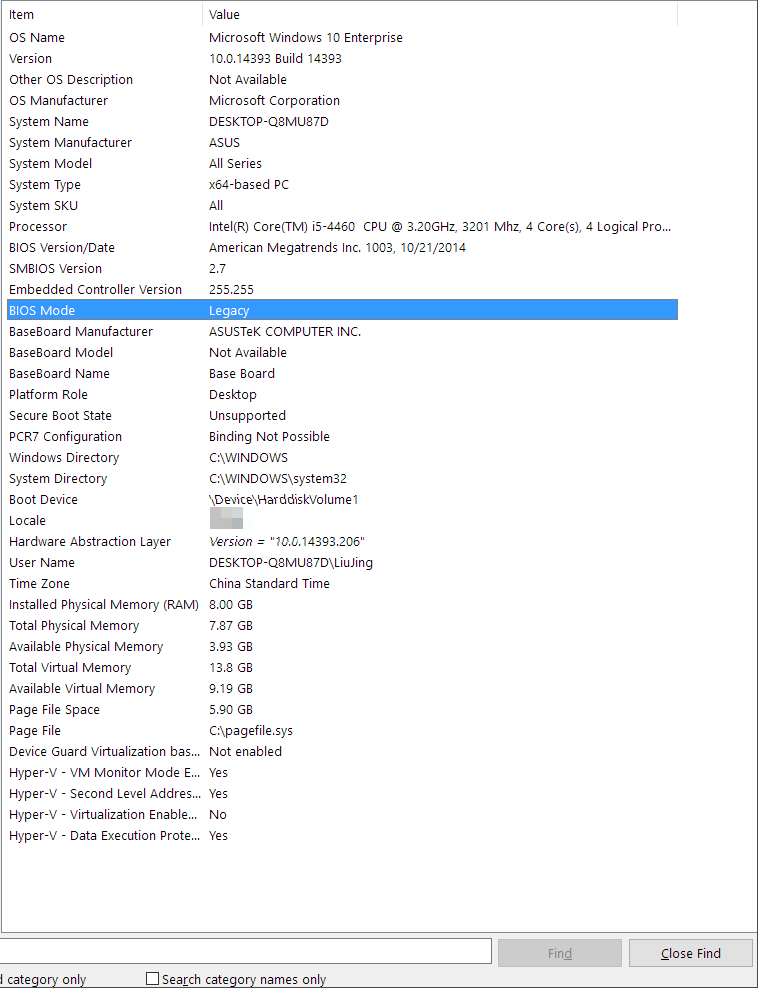
Option 2. Use setupact.log to Check If Your PC Uses BIOS or UEFI
Step 1. Open File Explorer, and go to the following path:
LocalDisk(c:)/Windows/Panther.
Step 2. Find and open the setupact.log file in Notepad.
Step 3. Locate the Detected Boot Environment, and there, you'll be able to check if your device is using BIOS or UEFI.
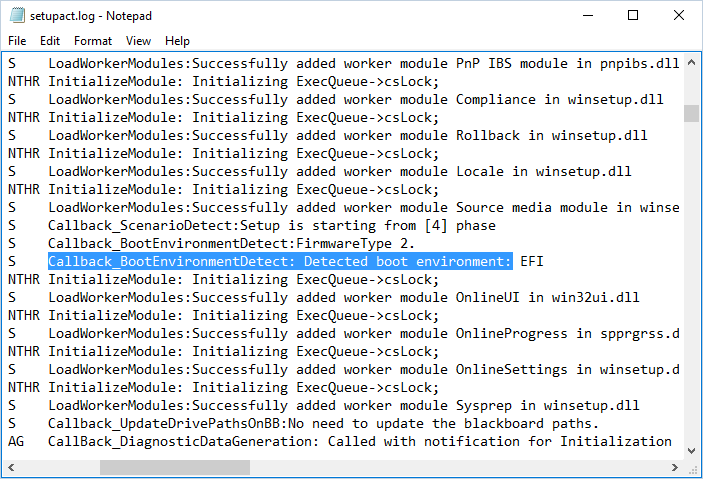
#2. Check If Your Windows Is MBR or GPT
So how to tell if your Windows OS drive is with MBR or GPT? Here is a quick guide that you can follow to check:
Step 1. Open Disk Management, right-click on the Disk 0, and select "Properties".
Replace 0 with the correct disk number of your Windows drive.
Step 2. Click the Volumes tab, then check the listed format next to Partition style.
You'll see the partition style - Master Boot Record (MBR) or GUID Partition Table (GPT).
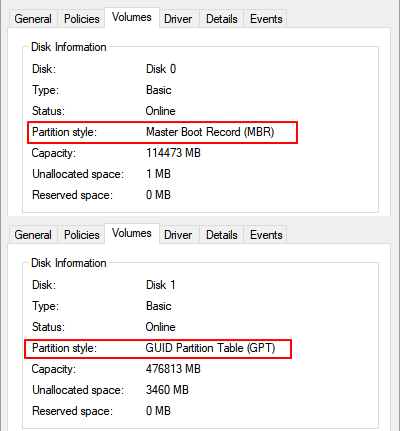
Now, you've known your computer's boot mode and disk partition style. Continue with the guide in the next part, and you'll learn how to set up the right mode in MBR for BIOS?
If you are looking for a reliable tool that works to convert disk between MBR and GPT without losing any data, EaseUS Partition Master is capable of help.
#3. Set Up Right Boot Mode in MBR for BIOS - Legacy or UEFI
To configure the right mode for your Windows disk, it's essential that you master some basic tips here:
- MBR is configured with BIOS Legacy Boot Mode.
- GPT is set up with UEFI Boot Mode.
So when to use MBR and when to use GPT disk? First, let's simplify the rule:
- Disks with 2TB or smaller capacity, you can set up the disk with MBR partition style.
- Disks with 3TB or even bigger sizes, set it up with GPT style.
Suppose that your OS drive is now 2TB or smaller, and it's now with MBR partition style. What boot mode is right for MBR? Yes, it's BIOS Legacy.
Here is the process that you can follow to set up the right boot mode in MBR for BIOS:
Step 1. Reboot the PC and press F2/F8/F11 or Del to enter the BIOS menu.
Step 2. Go to the Boot tab, select the Boot Mode, and use the up and down arrows key to select Legacy BIOS Boot Mode. Press Enter to confirm.
Step 3. Press F10 to save the changes and exit BIOS.
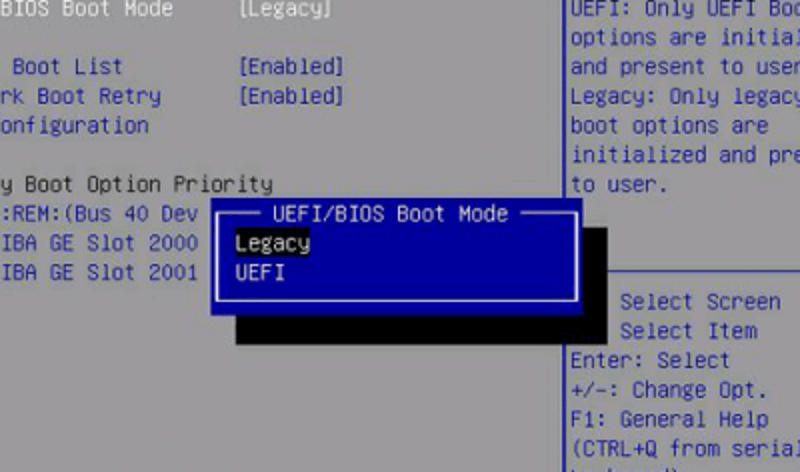
After this, you'll need to wait for the computer to reboot. When the process completes, Windows will be able to boot up successfully on your MBR disk.
If you are about to change your OS disk to GPT or migrate OS to a bigger GPT HDD/SSD, remember to follow the steps above to change the BIOS mode from Legacy to UEFI.
Was This Page Helpful?
Sherly joined EaseUS in 2022 and she has always loved writing articles and enjoys the fun they bring. She receives professional training here, focusing on product performance and other relative knowledge. She has written over 200 articles to help people overcome computing issues.
Written by Tracy King
Tracy became a member of the EaseUS content team in 2013. Being a technical writer for over 10 years, she is enthusiastic about sharing tips to assist readers in resolving complex issues in disk management, file transfer, PC & Mac performance optimization, etc., like an expert.
Related Articles
-
3 Effective Tools to Resize C Drive in Windows 7 [2026 Tutorial]
![author icon]() Tracy King/Jan 05, 2026
Tracy King/Jan 05, 2026 -
How to Check/View Disk Storage/Usage on Windows 10/11
![author icon]() Tracy King/Dec 23, 2025
Tracy King/Dec 23, 2025 -
How Do I Clear My Laptop Before Selling It on Windows 10
![author icon]() Brithny/Dec 23, 2025
Brithny/Dec 23, 2025 -
Free Download SD Memory Card Formatter for All Memory Cards
![author icon]() Tracy King/Dec 23, 2025
Tracy King/Dec 23, 2025